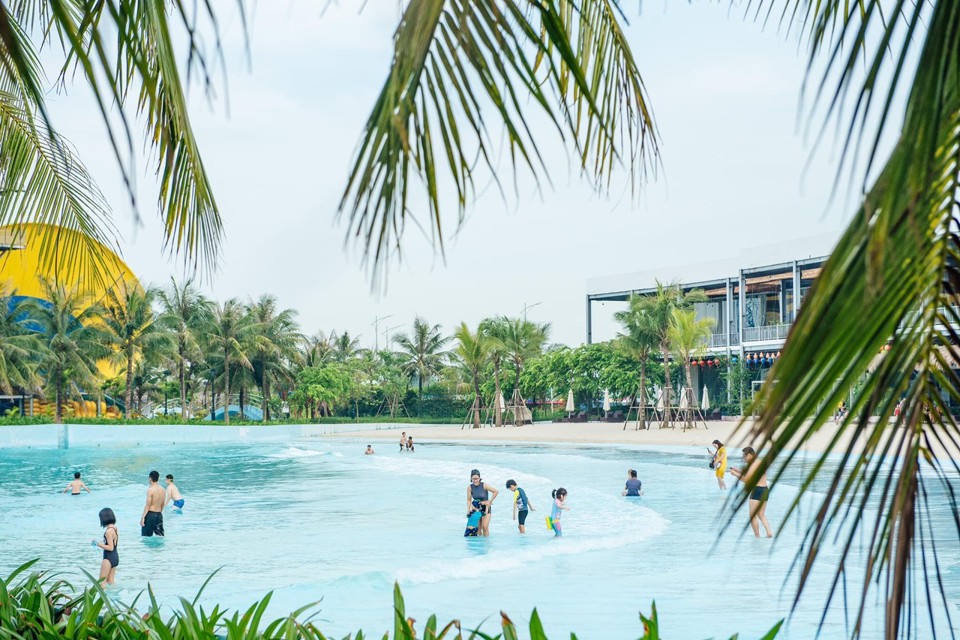
Quoc Oai District is an ancient land of the Doai region, with various intangible cultural heritage, several traditional handicraft villages, and rich historical relics, especially the two national special relics: Thay Pagoda and So Temple.
Despite the immense potential of these two relics, the local authorities have not been effective in the exploitation of the area's tourism potential. Therefore, a strong push is needed to awaken the tourism potential in the area, local insiders have said.
Attractive destinations
| Thay Pagoda is a "Special National Monument". Photo: Mai Huong |
Nguyen Duc Nam, Head of the Culture and Information Division of Quoc Oai District, said the district has over 200 historical, cultural, architectural, and artistic relics. Among them, the most unique cultural value is the cluster of national special relics, including Thay Pagoda (Sai Son Commune).
Thay Pagoda is closely associated with the name and life of Tu Dao Hanh, a revered Vietnamese Buddhist monk who lived under the Ly dynasty (1010-1225).
It is also a complex of relics combined with the landscape of low mountains in the midst of a fertile delta, creating a sacred and majestic appearance, including Thay Pagoda and the area around Sai Son Mountain and Hoang Xa Cave.
Another national treasure, So Temple in Cong Hoa Commune, is known as one of the most beautiful temples in the ancient Doai area, and it has unique artistic values.
Nguyen Thu Hang, who lives in Hoan Kiem District, visited So Temple and said that the ancient temple has preserved intact masterpieces of architecture and sculptures from the 17th century.
However, this relic has not received the attention it needs to become a spiritual and cultural tourism destination, she added.
In addition to the two national special relics, Quoc Oai district is also home to the Tuan Chau tourist site, which attracts many tourists with dolphin and seal shows, rural markets, and especially the live show "Tinh hoa Bac Bo" (the Quintessence of Tonkin).
The carefully staged performance program seamlessly fuses modern elements with deeply rooted folk traditions, leaving visitors with a profound sense of the vibrant culture of the Red River Delta region.
In addition, Quoc Oai has much potential to develop agricultural and rural tourism, community-based ecotourism, green tourism, and experiential tourism in Dong Xuan and Phu Man areas. Famous handicraft villages such as Ngoc Than Capentry Village (Ngoc My Commune) and the Noodle Village in So Village (Cong Hoa Commune) offer immersive experiences for tourists.
Despite abundant resources to develop various forms of tourism, Quoc Oai attracts tourists who only visit the special national relics area of Thay Pagoda and the Tuan Chau Ecological and Entertainment Complex. The number of visitors for sightseeing and tourism is still modest, about 300,000 people per year.
Enhancing promotion to attract visitors
| Tuan Chau beach in Quoc Oai District. Photo: Tuan Chau Group |
Deputy Director of the Hanoi Department of Tourism, Nguyen Hong Minh, said that, in order to attract tourists for sightseeing and resort stays, Quoc Oai District needs to create a "boost" to awaken the tourism potential in the area.
"The district should actively renew its products, invest resources in renovation and restoration of historical relics, develop tourist routes, and increase promotion on various information channels and social platforms," he added.
In this regard, Hoang Nguyen Ung, Deputy Chairman of Quoc Oai District People's Committee, said that in the resolution of the 13th Quoc Oai District Party Congress for the 2020-2025 period, tourism has been identified as an important economic sector.
Therefore, he added, the district's orientation is to develop tourism products based on the potential and strengths of each area, focusing on cultural festival tourism, spiritual tourism, resort tourism, eco-tourism, and handicraft village tourism.
Quoc Oai District has issued many policies and plans to attract tourists. The district has instructed departments and units to promote digital transformation in the tourism sector; actively build digital tourism maps for tourists and locals through website systems and application platforms with various utilities; provide various features and tourism information of the district to tourists, tourism businesses and state management agencies.
Ung stressed that the district has also created conditions for businesses, organizations, and individuals to develop new tourism products such as agrotourism, adventure tourism, and homestay tourism to attract visitors to Quoc Oai.
"Given the great potential and the implementation of various development policies, tourism activities in the district are expected to flourish going forward. By then, the number of visitors to the locality is expected to increase from the current 300,000 to 1 to 1.5 million per year by 2025-2030," Ung emphasized.






- PM visits domestic firms joining high-speed rail project
- Vietnam e-commerce sales to hit $15.4 billion in 2025
- Nearly 13,800 new jobs created in Hanoi in January
- Vietnam faces increased trade remedies amidst growing export success
- Vietnamese Government prioritizes refining e-commerce regulations to drive growth
- Green products to be focus of Vietnam's trade promotion in 2025


